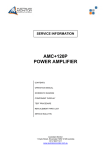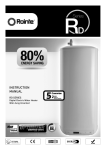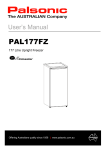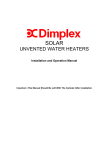Download Dimplex SUTP Mid Range Installation manual
Transcript
SUTP Mid Range Unvented Hot Water Heaters Installation Manual 30,50 & 75 Litres Important -This Manual Should Be Left With The Unit After Installation Table of Contents 1. Introduction.......................................................................................................................................2 2. Component Check List .....................................................................................................................3 3. General requirements ........................................................................................................................3 4. Plumbing Installation ........................................................................................................................5 7. Electrical installation.........................................................................................................................9 8. Filling and commissioning- ............................................................................................................10 9. Servicing and maintenance. ............................................................................................................11 10. Fault finding..................................................................................................................................12 11. Users instructions..........................................................................................................................13 12. Warranty........................................................................................................................................13 13. Installation, Commissioning and Service Record .........................................................................14 1. Introduction The “SUTP Mid Range” is a high quality unvented stainless steel domestic hot water cylinder suitable for domestic hot water systems where the cold mains water supply is between 3bar and 12bar. Reduced performance is available at lower pressures but the units are not suitable for pressures lower than 1.5bar and flow rate of 20 litres per minute. The unit comes complete with all the necessary safety equipment to comply with legislation governing the installation of such systems. 2 Technical Specification Model Number Storage capacity (litres) depth (mm) width (mm) Overall height incl t&p valve Height excl t&p valve Weight when full (kg) Cold feed/hot draw off connections (mm) Maximum water supply pressure (bar) System operating pressure (pre-set) (bar) Expansion vessel charge pressure (bar) Expansion relief valve set pressure (bar) Temperature and pressure relief valve settings: Lift pressure (bar) Lift temperature (ºC) SUTP30 SUTP50 SUTP75 30 400 400 665 586 47 22 12 3 3 6 50 400 400 860 781 71 22 12 3 3 6 75 400 400 1175 1093 100 22 12 3 3 6 7 90 7 90 7 90 Package includes*: Expansion vessel ltr 5 5 5 3bar pressure reducing valve, non return valve, 6 bar expansion relief valve, tundish • • • T/P valve 7bar 90degC factory fitted • • • 15mm to 22mm Tundish • • • Cylinder with 3kW immersion, thermostat, and manual reset thermal cut-out • • • • • • 36 25 55 38 85 60 Installation Manual Performance: Heat up time 15 to 65 ºC (min) Reheat time for 70% of contents (min) 2. Component Check List The SUTP water heater comes complete with all necessary safety equipment, please check through the components supplied and ensure that all parts are present: a. Water Heater b. 5 litre Expansion Vessel c. Pressure reducing valve d. Expansion relief valve e. Isolation valve f. Tundish g. Expansion vessel bracket Please contact our customer service department immediately should any part be missing. 3. General requirements 3.1. The “SUTP Mid Range” domestic hot water cylinder MUST be installed by a competent person in accordance with section G3 of the current Building Regulations. 3.2. Important - It is important that the installer reads and understands these instructions, unpacks and familiarises themselves with the equipment before commencing the installation. Failure to observe these installation instructions could invalidate the warranty. 3 3.3. Water supply – The water supply to the cylinder should be potable water direct from a public mains water supply with any water treatment equipment functioning correctly. For optimum performance the unit should be fed via a 15 mm diameter supply pipe direct from the mains water entry point to the property with supplies between 3bar and 12bar, however, the the unit can operate with a minimum supply pressure of 1.5 bar and a flow rate of at least 20 litres per minute, but flow from the outlets will be low if several outlets are used simultaneously. The cylinder control equipment is factory set to limit the system operating pressure to 3 bar. The maximum supply pressure into the pressure-reducing valve is 12 bar. 3.4. Taps and fittings - All taps and fittings incorporated in the unvented system should have a rated operating pressure of 7 bar or above. To allow for servicing and repairs the unit must be mounted at least 300mm above any surface or object, so that access can be gained to electric connectors and the heating element may be removed. The unit should be mounted close to an external wall so that the discharge pipe D2 can be routed to a safe visible place. The tundish should be mounted in a visible location so that it may easily be inspected. Unit should be mounted on or near external wall 3.5. Location – The unit is designed to be vertically wall mounted, indoors, in a frost-free environment. When choosing a suitable location for the cylinder, consideration should be given to the routing of the discharge pipe to a convenient point and also the availability of an adequate power supply for connecting the immersion heater. The wall onto which the cylinder is mounted should be of good sound masonry construction capable of holding the weight of the cylinder when full of water (See Technical specifications for weights). The position of the cylinder should be such that easy access is provided for servicing the controls and replacing the immersion heater should the need arise. min 100mm Pipe runs should be made as short as possible and lagged to prevent heat loss. min 300mm 3.6. Storage and handling – If the cylinder is not being installed immediately, it should remain in its carton with all pipe end protective caps in situ to prevent damage. We recommend that the cylinder be transported to its installation position with the outer carton in place. 3.7. Pipework connections – All Pipework connections to the cylinder MUST be made in accordance with Fig1. 4 4. Plumbing Installation 4.1. Connections. Connections MUST be made to the cylinder in accordance with Fig 1, and Fig 2. A drain cock (not supplied) should be fitted in the position shown in Fig 1 to facilitate draining of the cylinder. 4.2. Cold water supply – For best results, the cylinder should be fed by an uninterrupted 15mm supply pipe into the pressure reducing valve (PRV) with a supply pressure of between 3 and 12 bar maximum. The cylinder should not be used on any system with a supply pressure below 1.5 bar and a flow rate of less than 20 litres per minute. 4.3. Temperature and pressure relief valve – The temperature and pressure relief valve (T&P Valve) is supplied factory fitted to the cylinder. The T&P Valve must not be removed from the cylinder or tampered with in any way. The valve is pre calibrated to lift at 7 bar or 90 degrees centigrade and any attempt to adjust it will invalidate the warranty and could affect the safety performance of the unit. The outlet of the T&P valve should be routed in 15mm copper piping in a downward direction alongside the water heating unit to the tundish. The outlet of the expansion relief valve must be T’d into this pipe before the tundish so that any water exiting either valve can be seen draining through the tundish– see fig 2 4.4. Pressure Reducing Valve – The pressure relief valve should be installed in the cold water supply to the water heating unit with the arrow pointing in the direction of water flow as shown in figure 5. This can be connected to a supply pressure of between 1.5 and 12 bar. 4.5 Expansion Relief Valve this must be installed between the pressure reducing valve and the water heating unit in accordance with Figure 1. No other valve should be fitted between this valve and the cylinder. The expansion relief valve contains a non return valve. 4.6. Expansion vessel – A suitable expansion vessel with a pre-charge pressure of 3 bar is supplied for fitting to all water heating units in the range. The expansion vessel MUST be fitted between the expansion relief valve and the cylinder. The expansion vessel MUST be positioned with the entry point at the bottom. IMPORTANT: Regular checks must be carried out to ensure that the expansion vessel is correctly pressurised to 3 bar at all times. The expansion vessel should be installed using a standard t-connector between the expansion relief valve and the cylinder – see Figure 1. 4.7. Tundish – The tundish must not be positioned above or in close proximity of any electrical current carrying devices or wiring. The installation should conform with the requirements of item 7 below. 5 4.8 Connection arrangement for SUTP Mid Range Cylinder Fig 1 1 2 3 4 5 6 7 8 9 MAINS COLD WATER SUPPLY (15mm) STOP COCK (NOT SUPPLIED) PRESSURE REDUCING VALVE CHECK VALVE if supplied separately (included in RWC expansion relief valve) EXPANSION RELIEF VALVE - SET 6 BAR DISCHARGE PIPE 22mm DIA (SEE SECTION 7) DRAIN COCK (Not Supplied) TUNDISH EXPANSION VESSEL 4.9. Discharge arrangement. The Tundish must be installed in a position so that it is clearly visible by the user. In addition, the discharge pipe from the Tundish should terminate in a safe place where there is no risk to persons in the vicinity of the discharge, be of metal and: (a) Be at least one pipe size larger than the normal outlet size of the safety device unless its total equipment hydraulic resistance exceeds that of a straight pipe 9 m long, i.e. discharge pipes between 9 m and 18 m equivalent resistance length should be at least two sizes larger then the normal outlet size of the safety device, between 18 m and 27 m at least three sizes larger and so on. Bends must be taken into account in calculating the flow resistance. Refer to the diagram, tables and worked example detailed in Fig 2. 6 (b) Have a vertical section of pipe at least 300 mm long below the Tundish before any elbows or bends in the Pipework. (c) Be installed with a continuous fall (d) Have discharges visible at both Tundish and the final point of discharge, but where this is not possible or practically difficult, examples of acceptable discharge arrangements are: - Ideally below a fixed grating and above the water seal in a trapped gully - Downward discharge at low level, i.e. up to 100 mm above external surfaces such as car parks, hard standings, grassed areas, etc. are acceptable providing that where children play or otherwise come into contact with discharges, a wire cage or similar guard is positioned to prevent contact whilst maintaining visibility. - Discharge at high level, e.g. into a metal hopper and metal down pipe with the end of the discharge pipe clearly visible (Tundish visible or not) or onto a roof capable of withstanding high temperature discharges of water and 3 m from any plastic guttering system that would collect such discharges (Tundish visible). - Where a single pipe serves a number of discharges such as in blocks of flats, the number served should be limited to not more than six systems so that any installation discharging can be traced reasonably easily. The single common discharge pipe should be at least one pipe size larger than the largest individual discharge pipe to be connected. If unvented hot water stored systems are installed where discharges from safety devices may not be apparent i.e. in dwellings occupied by blind, or disabled people, consideration should be given to the installation of an electrically operated device to warn when discharge takes place. Warning Notice – The discharge will consist of scalding water and steam. Asphalt, roofing felt and non-metallic rainwater goods may be damaged by such discharges. Typical discharge pipe arrangement. Fig 2 7 Sizing of copper discharge pipe “D2” for common temperature relief valve outlet sizes Valve outlet Min size of size, diameter discharge pipe (inches) D1 in (mm) Min size of discharge pipe D2 from tundish in (mm) Max resistance allowed, expressed as a length of straight pipe, i.e. no elbows or bends. Resistance created by each elbow or bend (m) 22 up to 9 0.8 28 up to 18 1.0 35 up to 27 1.4 ___________________________________________________________________________ 1/2 3/4 15 22 28 35 42 up to 9 up to 18 up to 27 ------1.7 35 up to 9 1.4 42 up to 18 1.7 54 up to 27 2.3 ___________________________________________________________________________ 1 28 Worked example The example below is for a ½”diameter temperature relief valve with a discharge pipe (D2) having 4 22mm elbows and a length of 7 m from the tundish to the point of discharge. From Maximum resistance allowed for a straight length of 22mm copper discharge pipe (D2) from a ½”diameter temperature relief valve is: 9.0 m. Subtract the resistance for 4 No 22mm elbows at 0.8 m each = 3.2 m. Therefore, the maximum permitted length equates to: 5.8 m. 5.8 m is less than the actual length of 7 m, therefore, calculate the next largest size. Maximum resistance allowed for a straight length of 28mm pipe (D2) from a ½”diameter temperature relief valve equates to: 18 m. Subtract the resistance for 4 No 28mm elbows at 1.0 each = 4 m. Therefore the maximum permitted length equates to 14 m. As the actual length is 7 m, a 28mm diameter copper pipe will be satisfactory. 8 4.10 Secondary Return Where required the hot water outlet to the taps may be returned to the cold water inlet of the cylinder using a circulating pump. The secondary return should be connected as per Figure 3. Note the 5litre vessel included with the water heater is suitable for pipe lengths of up to 180m. For longer pipe runs the cylinder should be increased in size accordingly. Figure 3 7. Electrical installation WARNING: THIS EQUIPMENT MUST BE EARTHED. All electrical wiring must be carried out by a competent person and in accordance with the current I.E.E. Wiring Regulations. All pipework should be earthed! 7.1.The immersion heater - A 3kW 230v 50Hz immersion heater is pre fitted to the cylinder at the factory. It should be wired in accordance with the instructions given in Fig 4. The cable should be routed through the strain relief bush. 7.2. Wiring instructions a) The power supply to the heater must be via a double pole isolator switch or controller, having contact separation of at least 3 mm, using 1.5mm sq. flexible cable, 85°C rubber insulated HOFR sheathed, to comply with BS 6141 table 8 and must be fully earthed. Wire the water heater in accordance with the wiring diagram below: i. Connect the Earth wire to the terminal on the cylinder marked with the earth symbol. ii. Connect the Live wire to the high temperature cut-out terminal A1 iii. Connect the Neutral wire to the high temperature cut-out terminal B1 WARNING: DO NOT SWITCH ON THE ELECTRICITY SUPPLY UNTIL INSTRUCTED TO DO SO IN THE COMMISSIONING PROCEDURE AND THE UNIT IS FULL OF WATER. 9 Fig 4 WARNING: THIS APPLIANCE MUST BE EARTHED. 8. Filling and commissioning8.1. Check that the expansion vessel charge pressure is 3 bar. 8.2. Check that all water and electric connections are tight and correctly configured. 8.3. Open the main stopcock and fill the unit. Open successive hot taps starting with the tap furthest from the heater. Leave each tap open for a few moments to allow all air and debris from the system to exit. Close all of the taps. 8.4 Turn off the mains water supply to the cylinder and drain the system through the drain cock. 8.5 Refill the cylinder with hot taps open and close when water flows freely. 8.6 Manually lift (by rotating the knob) both the expansion relief and the temperature and pressure relief valves for a short period to remove trapped air from behind the valve seating and to prove the correct function of the discharge arrangement. 8.7. Check all joints for leaks and rectify as necessary. 8.8. With the heater full of water, turn the thermostat to a point just below its mid point setting and switch on the electricity supply. Check that the cylinder heats the water and the thermostat operates when the set temperature is reached. Turn on the hot taps to check that warm water is delivered to the 8.9 Check that while the unit is heating up, no water exits from either the expansion relief or the temperature and pressure relief valve. If water does exit through the valves check the expansion vessel pressure and installation. 8.10 Increase the temperature to maximum and allow the unit to heat and the temperature to stabilise. Check that no water discharges from the valves. Turn on the hot taps to drain the heater of hot water. Set the thermostat to the required temperature and allow the heater to reheat ready for use. 10 9. Servicing and maintenance. 9.1. Servicing and maintenance must only be carried out by a competent unvented hot water installer or by Glen Dimplex UK Limited authorised personnel. 9.2. Before any work whatsoever is carried out on the installation, it MUST first be isolated from the mains electricity supply. 9.3 Only use spare parts authorised by Glen Dimplex UK Limited. The use of other parts will invalidate the warranty. 9.4. Drain the cylinder – When draining the cylinder, always switch off the boiler and the immersion heater first. Turn off the water supply at the stopcock (see Fig 1). Connect a hosepipe to the drain cock (see Fig 1) and route it to a convenient gully. Open the drain cock and all hot taps that are served by the cylinder. The cylinder may take several minutes to empty completely. 9.5. In hard water areas it may be necessary from time to time to remove and de-scale the immersion heater element. Replace the gasket each time it is removed. 9.6. Remove the cartridge from the pressure reducing valve. Check the strainer and if necessary remove any debris from in front of it. Replace the cartridge. 9.7 .Check the charge pressure in the expansion vessel and top up as necessary. The charge pressure should be 3.0 bar. 9.8. Close the drain cock, disconnect the hose, refit the immersion heater and close all hot water taps before reopening the stopcock. Allow the cylinder time to fill whilst checking for any leaks. Release any air from the system by opening each hot water tap individually, starting with the one furthest from the cylinder. 9.9. Manually lift the expansion relief and temperature and pressure relief valve one at a time, every 12 months (more frequently in hard water areas) to prevent debris from building up behind the valve seat. Whilst carrying out this operation, check that the discharge to waste is unobstructed. Check that each valve seals correctly when released. As the valves are pre-calibrated, they require no further maintenance. 9.10. Finally, when the heater is full of water switch on the mains electricity supply to the immersion heater and the boiler. As the system heats up, check again for any leaks and rectify as necessary. 9.11 In the event of the manual reset cut-out operating, isolate the heater from the mains supply, investigate and identify the cause of the operation of this cut-out, rectify the fault before manually resetting the cut-out via the reset button on the cut-out. Finally switch the mains electricity supply back on. 11 10. Fault finding. Notice: Disconnect electrical supply before removing any electrical equipment cover. Fault Possible cause Remedy 1. Mains supply off 1. Open stopcock 2. Strainer in Pressure reducing valve blocked 2. Turn water supply off, remove strainer and clean. 3. Pressure reducing valve incorrectly fitted 1. Programmer if fitted is not switched on. 3. Re-fit correctly 2. High limit thermostat has tripped 3. Check and re-set Intermittent water discharge through tundish on warm-up 1. Expansion vessel has lost its charge pressure Continuous water discharge 1. Pressure reducing valve (PRV) not working 1. Turn off stopcock open a hot water tap check vessel charge pressure and recharge to 3 bar 1. Check pressure from Pressure reducing valve if greater than 3 bar replace cartridge No hot water Water from hot taps is cold 1. Set programmer to call 2. Expansion relief valve not seating correctly 2. Manually lift the valve once or twice to clear any debris from the seat otherwise replace valve 3. Temperature and pressure relief valve not seating correctly 3. Manually lift the valve once or twice to clear any debris from the seat otherwise replace valve 12 11. Users instructions. 11.1 Your “SUTP Mid Range” unvented hot water cylinder has been designed to give many years of trouble free service and is made from hygienic high grade stainless steel. 11.2. When a hot tap is turned on there may be a short surge of water, this is quite normal with unvented systems and does not mean there is a fault. 11.4. When you first fill a basin the water may sometimes appear milky. This is due to very tiny air bubbles in the water which will clear very quickly. 11.5. If water is seen dripping through the tundish at any time switch off the electricity supply immediately and call the installer or the Dimplex customer service department on the number listed at the end of this guide. 12. Warranty 12.1. Glen Dimplex UK Limited guarantee all electrical and mechanical controls supplied with the cylinder for a period of 2 years from the date of purchase provided that they have been installed for their intended use by a competent person and have not been modified in any way. 12.2. In addition Glen Dimplex UK Limited also guarantees the stainless steel hot water cylinder for a period of 10 years from the date of purchase against faulty material or manufacture provided that: (a) It has been installed by a competent person in accordance with this installation manual and all current regulations and codes of practice at the time of installation. (b) It has been used solely for the purpose of heating potable water that complies with current (at the time of installation) EU standards and is not fed with water from a private source. (c) It has not been modified in any way. (d) It has not been subjected to excessive pressure or electrolytic action from dissimilar materials, or attack from any salt deposits. (e) It has been installed indoors in a frost-free environment. (f) The warranty card is completed and returned to Dimplex UK Limited within 90 days of installation. This warranty is not transferable. This warranty does not include claims due to frost or lime scale damage. Proof of purchase will be required against any claim. This guarantee does not affect your statutory rights. For help about the SUTP Mid Range please contact the Dimplex Customer Services Department: Glen Dimplex UK: Millbrook House, Grange Drive, Hedge End, SO30 2DF Tel 0870 727 0101 Fax 0870 727 0109 13 13. Installation, Commissioning and Service Record CUSTOMER DETAILS NAME ADDRESS TEL No. INSTALLER DETAILS COMPANY NAME ADDRESS DATE TEL No. REGISTRATION No. INSTALLER NAME COMMISSIONING ENGINEER (IF DIFFERENT) COMPANY NAME ADDRESS DATE TEL No. REGISTRATION No. INSTALLER NAME CYLINDER DETAILS MODEL CAPACITY LITRES SERIAL NO. SERVICE RECORD DETAILS Before completing the appropriate Service Interval Record below, please ensure you have carried out the service as described in the manufacturer’s instructions and in compliance with all relevant codes of practice. It is recommended that your hot water system is serviced regularly and that your service engineer completes the appropriate Service Interval Record below. SERVICE 1 DATE: SERVICE ENGINEER TEL NO. REGISTRATION NO. SERVICE 2 DATE: SERVICE ENGINEER TEL NO. REGISTRATION NO. SIGNATURE SIGNATURE SERVICE 3 DATE: SERVICE ENGINEER TEL NO. REGISTRATION NO. SERVICE 4 DATE: SERVICE ENGINEER TEL NO. REGISTRATION NO. SIGNATURE SIGNATURE SERVICE 5 DATE: SERVICE ENGINEER TEL NO. REGISTRATION NO. SERVICE 6 DATE: SERVICE ENGINEER TEL NO. REGISTRATION NO. SIGNATURE SIGNATURE SERVICE 7 DATE: SERVICE ENGINEER TEL NO. REGISTRATION NO. SERVICE 8 DATE: SERVICE ENGINEER TEL NO. REGISTRATION NO. SIGNATURE SIGNATURE DATE: SERVICE ENGINEER TEL NO. REGISTRATION NO. SERVICE 10 DATE: SERVICE ENGINEER TEL NO. REGISTRATION NO. SIGNATURE SIGNATURE SERVICE 9 14























